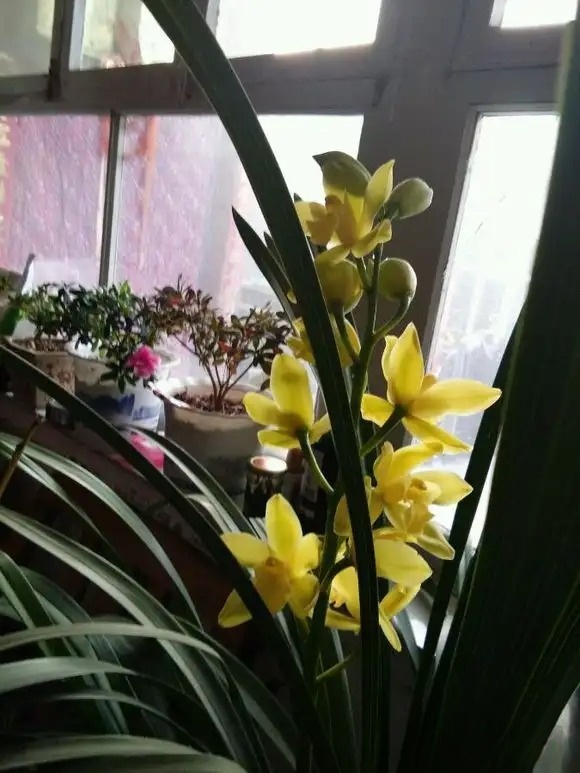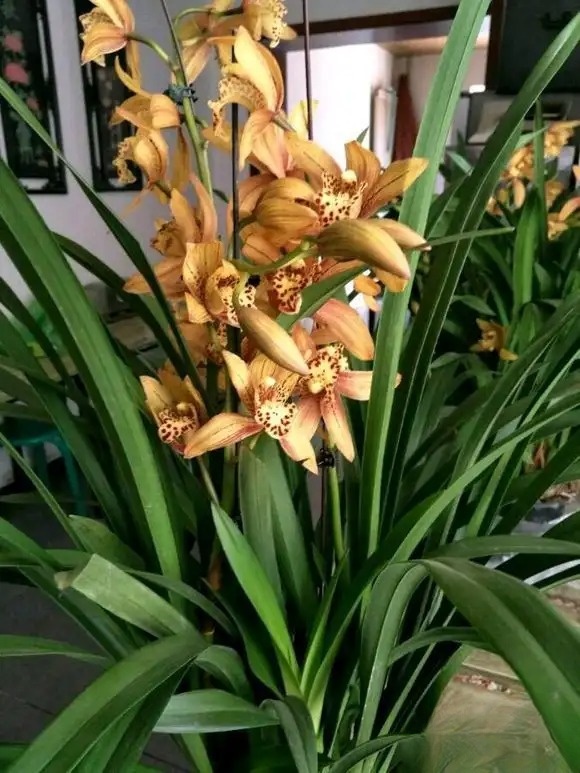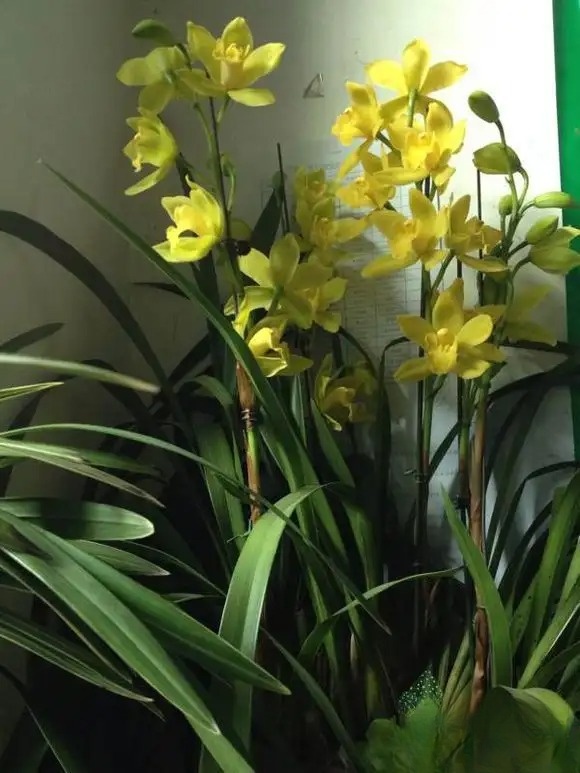Cultivation methods and precautions of Cymbidium orchid
Cymbidium orchid, also known as Himbel orchid, cicada orchid, and Simpyl orchid, is a general term for varieties of orchids that are bred through artificial hybridization, with bright colors and large flowers. There are currently nearly 20,000 cultivated varieties, which are very popular in domestic and foreign markets and have become a large variety group among orchids. Let’s take a look at how to grow cymbidium orchids!
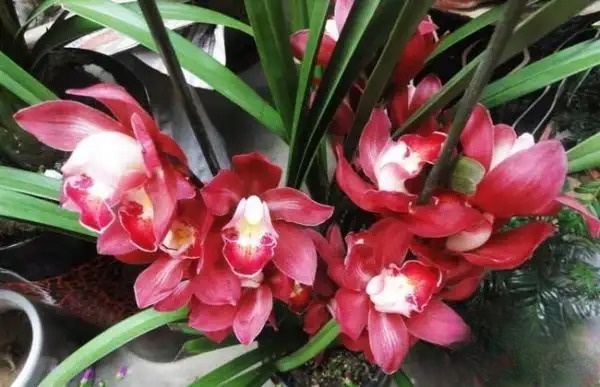
Requirements for growing cymbidium orchids
1. Soil: Cymbidium requires a loose, breathable and well-drained cultivation medium. It can be planted in leaf mold or mixed with moss, charcoal, fern roots, charcoal, bark blocks, broken bricks, etc. Poorly ventilated and poorly drained soil will cause root rot.
2. Watering: It likes moisture. In spring, summer and autumn, in addition to providing sufficient water to the roots, the leaves should also be sprayed with water frequently. After flowering in early spring, during the short dormant period, it is necessary to water less, and then water more when the new buds grow larger new roots.
3. Sunlight: Cymbidium orchids prefer sufficient diffuse light. Use a shade net to shade about 50% in summer and autumn. Open the shade net to receive direct sunlight on cloudy days or when the sunlight is soft in winter and spring.
4. Temperature: It likes warm winter and cool summer, and the suitable temperature for growth is 10℃ to 25℃. The night temperature should be around 10℃, especially during the flowering period, the temperature should be maintained above 5℃, and below 15℃ can extend the flowering period by more than 3 months.
5. Fertilization: Thin fertilizers should be applied frequently during the growth period. Thin chemical fertilizers or compound fertilizers can be applied. If more bone meal and decomposed bean cake fertilizer are applied, the flowers will be larger and more numerous. Liquid fertilizers should be diluted at 1:1000 and applied once every 10 days. Sufficient fertilizers should be applied before flowering. Do not apply fertilizers during the flowering period and midsummer.
6. Pests: If the cultivation environment of cymbidium is not good, it is easy to be harmed by pests and diseases. Common diseases include fusarium, black rot, soft rot, anthracnose, gray mold, white rot, etc. Therefore, fungicides should be sprayed once every half a month to prevent the occurrence of diseases. Special attention should also be paid to the cleaning of environmental hygiene, water sources, planting materials and utensils.
7. Pruning: The pseudobulbs of Cymbidium orchids generally contain more than 4 leaf buds. In order to prevent the nutrients from being dispersed, the new buds and their growth points must be completely removed. This operation should start from the end of the flowering period, and the buds should be removed once a month until the new flowering period. This can concentrate nutrients, strengthen the mother bulb, and make the flowers bloom larger and more.
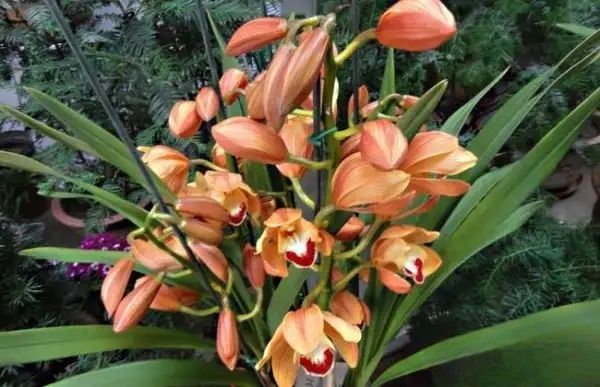
Cymbidium orchid propagation method
1. Cymbidium orchids are often propagated by division, which is usually done during the short dormant period after the plant blooms and before the new buds grow up.
2. The orchids should be properly dried before division, and the operation should be performed when the roots are slightly white and soft. Strong orchids are usually divided every 2 to 3 years. After division, each clump of orchid seedlings should have 2 to 3 pseudobulbs, one of which must be newly formed in the previous year.

What soil to use for cymbidium
1. What kind of soil should be used for cymbidium orchids? Cymbidium orchids are epiphytic flowers. In the wild, they grow on tree trunks and rocks in the forest by relying on their roots. Therefore, cymbidium orchids are often cultivated in ceramic flower pots with porous walls. 1 part of peat moss, 2 parts of fern roots, or bark blocks with a diameter of 1.5 to 2 cm, broken bricks, charcoal, pot pieces, volcanic ash and other granular materials are used as potting materials. Do not use the culture soil for planting orchids and general flowers, otherwise the ventilation and water permeability in the pot will be poor, which will easily cause root rot.
2. Cymbidium orchids like to grow in loose, breathable and well-drained soil. It is recommended to use leaf mold. In addition, homemade culture soil mixed with moss, fern roots, charcoal, bark blocks, broken bricks, etc. is also a very good choice. Try not to use ordinary culture soil and culture soil for growing Chinese orchids. If the soil has poor drainage and exhaust effects, it is easy to cause cymbidium orchid roots to rot.
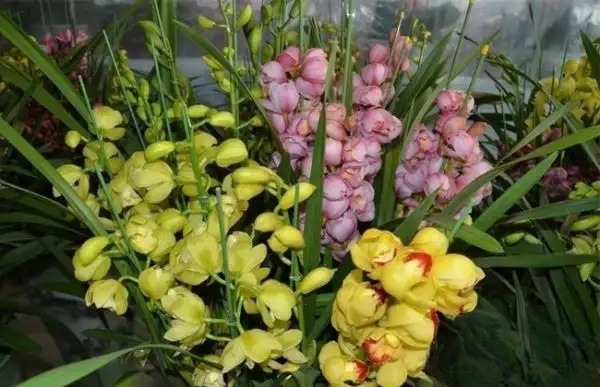
Precautions for repotting Cymbidium orchids
1. The hydroponic system using clay pebbles as the planting medium can promote air flow to the roots and gently and evenly transfer the nutrient solution to the cymbidium. Cymbidium grows in northern regions and is best placed outdoors in summer and autumn. Using clay pebbles to plant cymbidium will almost never cause root rot. The best time to repot cymbidium is after it blooms.
2. Remove the withered flower stems. Use a sharp blade to cut off the base of the plant. Then grab the plant and pull it up. Cymbidium orchids have thick leaves, which allow them to withstand a lot of pulling force. If you can't pull it up, you can use a tool to cut the flower pot. Please pay attention to using clean tools to prevent infection. Next, clear the substrate within centimeters of the root, and remove it slowly. It is important to remove the rest of the substrate. Soaking it in water for a few hours can make it easier to remove the substrate.
3. Use a clean, sharp knife to remove all rotten roots. The roots will grow rapidly under the new hydroponic system. When removing roots, be careful not to remove the roots of new growth points. Place some pebbles at the bottom of the pot, then place the plant, fill it with pebbles, and shake the pot so that the pebbles can fill the pot. In this way, we have planted the cymbidium. Clay pebbles will not rot, so when you need to move the cymbidium to a larger pot, you only need to move the cymbidium to a larger pot.
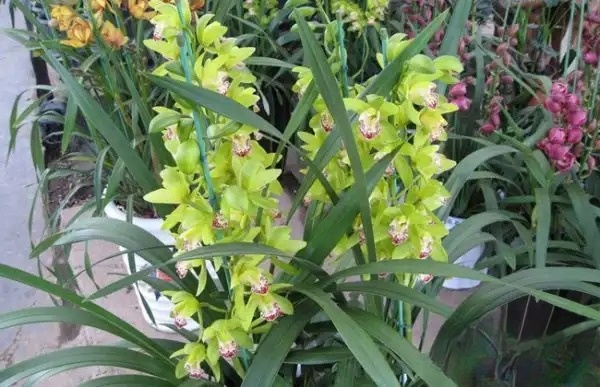
When does the large-flowered cymbidium bloom?
1. Cymbidium is native to the southwest. It likes warm winter and cool summer climate, high humidity and strong light. The suitable temperature for growth is 10℃ to 25℃. The night temperature is preferably around 10℃, especially during the flowering period, the temperature should be maintained above 5℃. If it is below 15℃, the flowering period can be extended to 4 to 5 months. The flowering period can be from October to April of the following year depending on the variety.
2. It takes 3 years for factory cultivation from tissue culture seedlings to flowering. Cymbidium orchids are divided into mother bulbs, daughter bulbs, and grandchild bulbs. Among them, grandchild bulbs grow the fastest. Cymbidium orchids like strong light and can withstand strong light of 50,000 to 70,000 lux.
3. Cymbidium is native to tropical and subtropical plateaus in Asia. It likes a cool and humid environment. The optimum temperature for its growth is 10-25℃. It should be placed in a low-temperature greenhouse for management in winter. When the temperature is around 10℃ at night, it grows well, the flower stems elongate normally, and it blooms mostly in February and March. When the temperature is below 5℃ in winter, the leaves are slightly yellow, the flowering period is delayed, and the flower stems are short. However, when the wintering temperature is around 15℃, the leaves of the plant are green and shiny, but the flower stems will suddenly elongate, and the flowering will be advanced to January and February. The flower stems are soft and cannot stand upright, and must be supported by pillars.
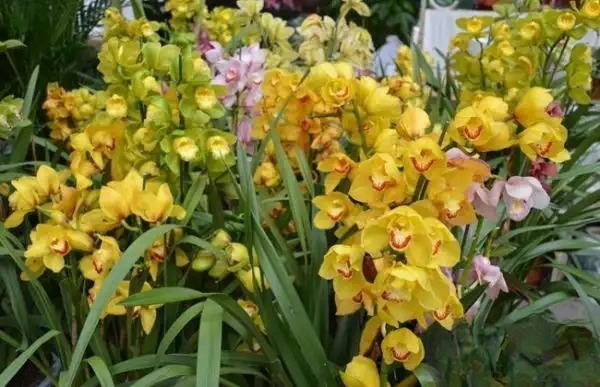
Repotting process of large-flowered cymbidium
1. Preparation of materials. The material for cymbidium is generally 70% pine bark (finger-sized, it doesn't matter whether it is new or old), and 30% orchid granules (medium or slightly smaller particles, stone chips mixed with cement can also be used). Sift through with a plastic basket for washing vegetables. No powder should be present. Soak them in water before planting, dry them, and mix them for later use.
2. Use a pot. There is no particular preference for the pot. Plastic pots or purple clay pots will do. But it must be larger than the original roots. Not too large, just enough to fit a layer of material around them (hold the roots with both hands and place them against the edge of the pot). The roots of the Cymbidium must be "squeezed" in the pot. The more squeezed, the more flowers will bloom (many people don't know this secret. They think the flowers bloom so well with such a small nutrient bag!).
3. Change the pot, cut the soft pot open, check if there are any rotten roots, if there are, cut them off, if not, just put the whole thing in the new pot, put some broken flower pots at the bottom of the pot first, then put some materials, let the pseudobulb be higher than the pot surface, put materials from all sides, and shake it tight. If you want to use a high pot for beauty, you need to raise the bottom, you can use a broken tile pot to empty it to a suitable place so that the materials do not leak, or you can use a plastic orchid pot to make some big holes, turn it upside down in the high pot, the size depends on the pot, which can reduce the weight of the whole pot of flowers and save planting materials, but you must not put plastic foam blocks at the bottom, although the plastic foam blocks are light, but the roots of orchids hate this thing the most.
4. Management and care of this flower do not need to be taught, just water and fertilize it! The fact that Cymbidium orchids need a lot of water and fertilizer may be beyond the expectation of many people. Water it every day, and you can use some "Hao Kang Duo" as a long-term fertilizer, but you also need to supplement fertilizer at ordinary times. Use nitrogen, phosphorus and potassium balanced fertilizer from April to June. July and August are the flower bud differentiation period, and you need to apply some high-phosphorus fertilizer every three or four days, just dissolve it in water. Apply less fertilizer after October, and if you apply fertilizer again, the flower buds will turn into leaf buds. Cymbidium orchids usually bloom on the new seedlings of the year, so cultivating the new seedlings of the year is the key. As long as the new seedlings grow, it will undoubtedly bloom. Cymbidium orchids need plenty of sunlight, generally it is better not to sunburn the leaves, usually 60-70% of the sunshade net is enough.
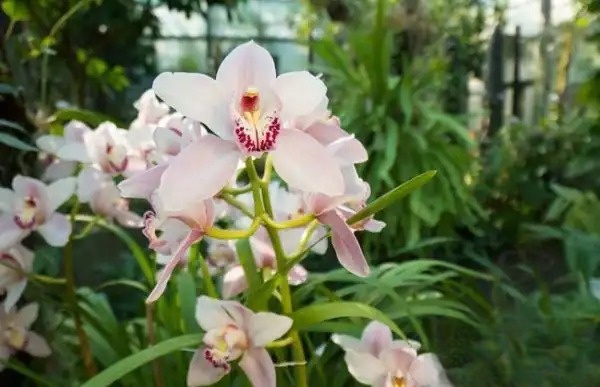
Methods for re-flowering of cymbidium orchid
1. Cymbidium is a species that is not easy to re-flower. The reason why it is not easy to re-flower is that it has very high requirements for growth (flowering) conditions; there must be sufficient nutrients for its growth. The environmental humidity is required to be 70-80%, the shade is 60-80% (double-layer shade net), and the temperature is 16-28 degrees. The most important point is that the temperature difference between day and night must be at least 10 degrees. In winter, there must be a low temperature of at least 2-5 degrees for more than a month to facilitate vernalization.
2. Cymbidium orchids have high requirements for water quality. They prefer slightly acidic water and are sensitive to calcium and magnesium ions in the water. Rainwater irrigation is the most ideal. They need high air humidity during the growth period. If the humidity is too low, the plants will grow poorly, the root system will grow slowly and be small, the leaves will become thick and narrow, and the leaf color will be yellowish. In general, Cymbidium orchids are afraid of dryness but not wetness.
3. Cymbidium orchids are light-loving plants in the orchid family. Sufficient light is beneficial to leaf growth and flower bud differentiation. Too much shade will cause the leaves to be slender and thin, unable to stand upright, and the pseudobulbs to become smaller and prone to disease, affecting flowering. Shading 50% to 60% in midsummer and more sunlight in autumn are beneficial to the formation and differentiation of flower buds. In winter, if auxiliary light is added on rainy and snowy days, it is extremely beneficial to flowering.
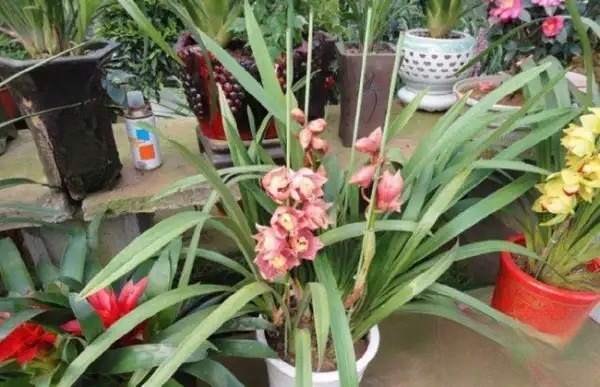
Cymbidium orchid yellow leaves with burnt edges
1. Improper watering: Although cymbidium orchids like moisture, due to the strong moisture retention of its potting medium and its fleshy root system, it is more resistant to mild drought. Therefore, it is recommended not to water too much or too frequently. Water with clean water close to room temperature. Do not water with fertilizer during the flowering period. Fertilizer should be applied after the flowering period, otherwise the flowering period will be shortened. Fertilizer damage may occur if fertilizer is used improperly. The number of days between watering can be controlled according to the room temperature. Water slowly and do not rush.
2. Improper transplantation: The annual flowers such as cymbidiums sold on the market are all replaced with beautiful and noble porcelain pots. However, during the repotting process, some merchants add some flower soil to the pots because the pots are larger. However, some of the flower soil is not fully decomposed. When the organic matter is fermented and releases heat after it is transferred to the pots and sold, it will cause damage to the flowers. The roots are burned and rotten, causing yellow leaves or death of the plants. It is recommended to carefully check the flower pot soil to ensure that the flowers grow healthily.
3. Cold air damage: Although cymbidium orchids are relatively cold-resistant, they cannot withstand low temperatures. On the way home from purchase, they may be hit by cold air, causing damage to leaves or flowers. The symptoms did not show up at the time, but only appeared slowly after a few days. For this type of damaged flowers, you can only cut off the yellow leaves and slowly adjust them, but it is generally not fatal.
4. Unsuitable micro-environment: Cymbidium orchids like relatively high air humidity. If the indoor air humidity is low and the temperature is high, it is easy for leaves to turn yellow and burn. You can spray water several times a day to increase the humidity of the micro-environment. In addition, if there is direct air conditioning or close to a heater, which is prone to dry micro-environment, it is also very easy for leaves to burn and turn yellow. When this phenomenon occurs, just adjust it. But the yellow leaves can only be cut off.
5. Too poor lighting: Cymbidium orchids like light but are afraid of direct strong light. Generally, scattered light is better. Too weak light can also cause poor growth and some symptoms. Generally, the placement of flowers for indoor appreciation is determined by the indoor location, but at this time, you should also pay attention to whether the flowers can adapt to the small environment of this location.
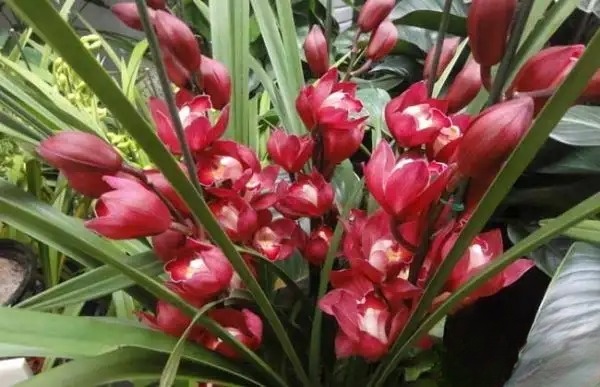
The Flower Language of Cymbidium
1. The nickname of Cymbidium is Tiger Orchid, which has different nicknames in different countries. For example, in Japan, people call it "East Asian Orchid", and in Europe and America it is called "New Beauty Orchid". The flower posture of Cymbidium is rough and bold, which combines the elegance of Chinese orchids and the beauty of foreign orchids. Its flower language is abundance, peace, nobility and grace.
2. The price of cymbidium orchids changes every year according to the market. Generally, the price of cymbidium orchids will rise during holidays. It also needs to be divided according to its quality. Generally speaking, the wholesale price of top-quality cymbidium orchids with more than 4 arrows is 150-200 per pot. In flower shops everywhere, it will be higher. The mid-range cymbidium orchids with 3-4 arrows are around 100-150, and the lowest cymbidium orchids are priced below 100 yuan.
Appreciation of domestic cymbidium
